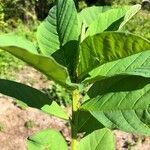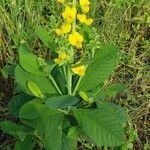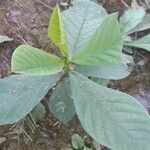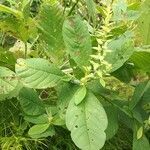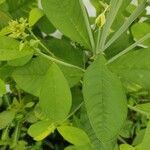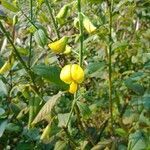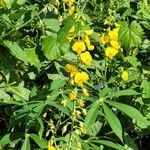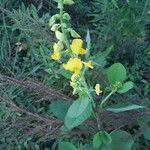Erect usually well branched annual, up to 2 m. tall.. Stem angled, sulcate, subglabrous.. Leaves simple; blade oblanceolate or obovate, up to 8–14 cm. long and 3–8 cm. wide, glabrous above, appressed pubescent beneath; petiole ± 2–8 mm. long.. Stipules obliquely oblong-ovate, up to 3–7 mm. long, 2–4 mm. wide.. Racemes shortly pedunculate, rather lax, up to 21–45 cm. long, many-flowered; bracts cordate, up to 12–20 mm. long, 6–10 mm. wide, acute or acuminate; bracteoles inserted near the middle of the pedicel, lanceolate, 1–2 mm. long.. Calyx 11–14 mm. long, with the tube protracted on the lower side, glabrous; upper lobes broadly triangular or slightly ovate-triangular, longer than the tube.. Standard suborbicular, yellow, glabrous outside; wings obovate-oblong, longer than the keel; keel rounded about the middle, with a fairly short slightly incurved twisted beak, ± 13–14 mm. long.. Pod shortly stipitate, broadly oblong-clavate, ± 45–50 mm. long, 18–20 mm. across, glabrous, ± 20–24-seeded.. Seeds oblique-cordiform, with the narrow end strongly incurved, ± 4 mm. long, smooth, brown.
Herbs, erect, 0.6-1.5 m tall. Branches terete, glabrous. Stipules ovate-triangular, ca. 1 cm. Leaves simple; petiole 2-8 mm; leaf blade oblanceolate to narrowly elliptic, 7-15 × 2-5 cm, thin, abaxially appressed silky pubescent, adaxially glabrous, base broadly cuneate, apex obtuse and mucronate. Racemes terminal, 20-30-flowered; bracts ovate-triangular, 7-10 mm. Pedicel 1-1.5 cm; bracteoles inserted at or apical to middle of pedicel, linear, ca. 1 mm. Calyx 2-lipped, 1.2-1.5 cm, glabrous; lobes broadly lanceolate-triangular, longer than tube. Corolla pale yellow; standard veined purplish red, suborbicular to oblong, 1-2 cm, base with 2 appendages, apex obtuse to retuse; wings obovate, ca. 2 cm; keel rounded about middle, with a fairly short and slightly incurved twisted beak exserted beyond calyx. Legume broadly oblong, 2.5-3 × 1.5-2 cm, 20-30-seeded, shortly stipitate, glabrous. Seeds smooth. Fl. Aug-Oct, fr. Oct-Dec.
Erect usually well-branched annual 1-2 m tall; stem angled, sulcate, sublgabrous. Leaves simple; blade oblanceolate or obovate, 8-14 x 3-8 cm, appressed pubescent beneath; petiole ±2-8 mm long. Stipules obliquely oblong-ovate, 3-7 x 2-5 mm. Racemes rather lax, mostly 20-50 cm long, many-flowered; bracts ovate-cordate, 8-20 x 5-10 mm, acute or acuminate; bracteoles on the pedicel, lanceolate, 1-2 mm long. Calyx 1.1-1.4 cm long, glabrous; upper lobes broadly triangular or slightly ovate-triangular, longer than the tube. Standard subcircular, yellow, lined reddish purple, glabrous outside; wings obovate-oblong, longer than the keel; keel rounded about the middle, with a fairly short slightly incurved twisted beak, 1.3-1.4 cm long. Legume shortly stipitate, broadly oblong-clavate, 4.5-5 x 1.8-2 cm, glabrous, 20-24-seeded. Seeds oblique-cordiform, with the radicular lobe strongly incurved, 4 mm long, smooth.
Stems erect, to 1 m; principal lvs narrowly obovate from a cuneate base, to 15 cm; racemes terminal and axillary, elongate and many-fld, the central one to 3 dm; bracts ovate, 8–12 mm; cal glabrous; standard 15–25 mm. Native of the Old World tropics, widely naturalized in tropical regions; se. Va., Mo., and scattered through s. U.S. Late summer.
An annual herb or small shrub. It grows 2 m high. The leaves are 5-15 cm long The flowers are in groups of 20-50 in stalks 25-45 cm long at the ends of branches. The flowers are yellow. The fruit is 2-5 cm long. There are 20-30 seeds.
